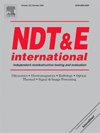Assessing accuracy of an efficient analytical-finite element framework for modelling guided wave scattering from corrosion defects in pipes
IF 4.1
2区 材料科学
Q1 MATERIALS SCIENCE, CHARACTERIZATION & TESTING
引用次数: 0
Abstract
Modelling guided ultrasound in pipelines is crucial for testing new approaches, understanding physical behaviour, and validating methods in non-destructive evaluation. Fully numerical methods like the finite element method accurately simulate ultrasonic inspections for realistic geometries but are limited by computational memory and processing needs, especially for large structures like long pipes. This work examines the accuracy of a methodology integrating analytical dispersion curves with finite element modelling. Dispersion curves model guided wave propagation over long, uniform sections of the pipe, whilst finite element modelling handles geometrical complexities such as defects. This integrated model maximises numerical modelling potential without overwhelming computational resources. The method was applied to analyse torsional T(0,1) mode scattering from corrosion defects using a GPU-based FEM solver and Fast-Fourier Transform decomposition of scattered wavefields. The effect of mesh refinement on performance of the integrated model is analysed, considering individual variations in axial, circumferential, and radial element sizes. These findings can significantly reduce the spatial domain needing numerical calculation, enhancing computational efficiency.
用于管道腐蚀缺陷导波散射建模的有效有限元分析框架的准确性评估
在管道中建立引导超声模型对于测试新方法、理解物理行为和验证非破坏性评估方法至关重要。像有限元法这样的全数值方法可以准确地模拟实际几何形状的超声波检测,但受到计算内存和处理需求的限制,特别是对于像长管道这样的大型结构。这项工作考察了将解析色散曲线与有限元建模相结合的方法的准确性。色散曲线模拟导波在管道长而均匀截面上的传播,而有限元模型处理几何复杂性,如缺陷。这个综合模型在没有压倒性的计算资源的情况下最大限度地发挥了数值模拟的潜力。利用基于gpu的有限元求解器和散射波场的快速傅立叶变换分解,将该方法应用于腐蚀缺陷的扭转T(1,1)模式散射分析。考虑轴向、周向和径向单元尺寸的个体变化,分析了网格细化对集成模型性能的影响。这些发现可以显著减少需要数值计算的空间域,提高计算效率。
本文章由计算机程序翻译,如有差异,请以英文原文为准。
求助全文
约1分钟内获得全文
求助全文
来源期刊

Ndt & E International
工程技术-材料科学:表征与测试
CiteScore
7.20
自引率
9.50%
发文量
121
审稿时长
55 days
期刊介绍:
NDT&E international publishes peer-reviewed results of original research and development in all categories of the fields of nondestructive testing and evaluation including ultrasonics, electromagnetics, radiography, optical and thermal methods. In addition to traditional NDE topics, the emerging technology area of inspection of civil structures and materials is also emphasized. The journal publishes original papers on research and development of new inspection techniques and methods, as well as on novel and innovative applications of established methods. Papers on NDE sensors and their applications both for inspection and process control, as well as papers describing novel NDE systems for structural health monitoring and their performance in industrial settings are also considered. Other regular features include international news, new equipment and a calendar of forthcoming worldwide meetings. This journal is listed in Current Contents.
 求助内容:
求助内容: 应助结果提醒方式:
应助结果提醒方式:


